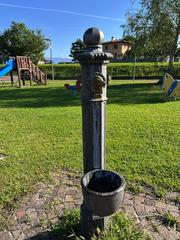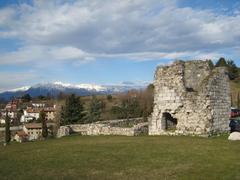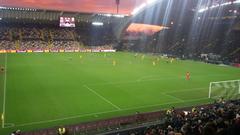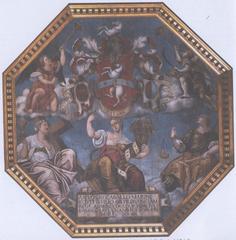Udine Cathedral: Visiting Hours, Tickets, and Historical Sites in Udine
Date: 15/06/2025
Introduction
Udine Cathedral, officially known as the Cattedrale di Santa Maria Maggiore, is a monumental symbol of the religious, cultural, and artistic heritage of Udine and the Friuli Venezia Giulia region of Italy. Founded in the early 13th century under the patronage of Berthold, Patriarch of Aquileia, the cathedral has undergone centuries of architectural evolution—beginning with its Romanesque-Gothic origins and culminating in a grand Baroque interior by Domenico Rossi in the 18th century, funded by the influential Manin family. This rich architectural layering mirrors the spiritual traditions of Udine and the city’s history, shaped by Venetian, Austrian, and Friulian influences (Spotting History; Wikipedia; Turismo FVG).
The cathedral serves as the seat of the Archbishop of Udine and is centrally located at Piazza Duomo, near other key landmarks such as Piazza della Libertà. Its Romanesque-Gothic brick façade, intricately carved portals, and Baroque interior—adorned with works by Tiepolo, Amalteo, and Pellegrino da San Daniele—make it a focal point for religious, artistic, and community life (thegoguy.com; lascimmiaviaggiatrice.it). This guide details Udine Cathedral’s history, architecture, visiting hours, ticketing, accessibility, and nearby attractions for an enriching visit (Diocese of Udine; Turismo FVG).
Historical and Architectural Overview
Early Foundations and Medieval Construction
Construction of Udine Cathedral began in 1236 under Patriarch Berthold of Aquileia. The Latin cross plan, three aisles, and side chapels reflected the prevailing Romanesque-Gothic style and the influence of Franciscan churches. By 1257, the cathedral was opened for worship and initially dedicated to Saint Odoric, before being rededicated to Santa Maria Maggiore in 1335, underscoring the region’s growing Marian devotion (Italyscapes; Turismo FVG).
Fourteenth-Century Transformations and Restoration
In 1348, an earthquake damaged the cathedral, prompting extensive restoration led by Venetian architect Pierpaolo dalle Masegne in 1368. This period saw the replacement of the original rose window and the addition of two significant portals: the Portale della Redenzione (14th century) with reliefs of the Redemption, and the Portale dell’Incoronazione (1395–1396) featuring scenes from the Life of Jesus (Spotting History; Italyscapes; Wikipedia).
Renaissance and Baroque Renovations
The 16th and especially the 18th centuries brought transformative changes, with the Manin family commissioning architect Domenico Rossi for a Baroque redesign completed in 1735. This introduced monumental Baroque features to the interior and enriched the cathedral with works by Giovanni Battista Tiepolo, Pomponio Amalteo, Maffeo Verona, Ludovico Dorigny, and Pellegrino da San Daniele (Turismo FVG; Spotting History).
Twentieth-Century Preservation
Modern interventions have focused on preserving the Romanesque-Gothic façade and safeguarding the cathedral’s historical and artistic integrity (Turismo FVG).
Architectural Features and Artistic Heritage
Exterior: Facade, Portals, and Bell Tower
The cathedral’s brick façade, with its Romanesque-Gothic portals and smaller rose window, preserves its medieval character. The Portale della Redenzione and Portale dell’Incoronazione display fine German craftsmanship and religious iconography. The bell tower, begun in 1441 by Cristoforo da Milano, was intended to be taller and surmounted by a Virgin statue, visually connecting it with other city landmarks (Italyscapes; thegoguy.com).
Interior: Nave, Altars, Chapels, and Artistic Masterpieces
The Baroque interior features three naves divided by pillars, with four chapels along each nave. The main altar by Giuseppe Torretto is crowned by statues depicting the Annunciation. Significant side altars by Giuseppe Pozzo and frescoes by Tiepolo and others adorn the chapels. The Chapel of the Holy Sacrament, with Tiepolo’s works, is a highlight, as are the vibrant frescoes and decorative elements reflecting the Venetian school (lascimmiaviaggiatrice.it).
The ground floor of the bell tower houses a chapel with frescoes by Vitale da Bologna (1349) and the Museo del Duomo, which exhibits religious art and artifacts (Wikipedia; Turismo FVG).
Integration with Urban Context
Located at Piazza Duomo, the cathedral is surrounded by Renaissance and Baroque buildings and is within walking distance of other attractions such as Piazza della Libertà, the Loggia del Lionello, and Udine Castle. The bell tower provides panoramic views over the city and the Friulian landscape (thegoguy.com; National Traveller).
Religious and Cultural Significance
As the seat of the Archbishop, Udine Cathedral is the spiritual heart of the city and the focal point for major liturgical celebrations. Its dedication to Santa Maria Maggiore underscores the region’s Marian devotion. The cathedral is also central to local festivals and social gatherings, especially during events like the Friuli DOC Festival (Understanding Italy; Try Travel).
The preservation of artworks by Tiepolo and others, as well as the hosting of concerts and cultural events, reinforce its dual function as a place of worship and a living museum of Friulian art (Understanding Italy).
Visitor Information
Visiting Hours
- Monday–Saturday: 8:00 AM – 12:00 PM and 3:00 PM – 7:00 PM
- Sundays and religious holidays: 8:00 AM – 1:00 PM and 3:30 PM – 7:00 PM
Hours may change for special events. Always check the official cathedral website for updates.
Tickets and Guided Tours
- Cathedral Entry: Free
- Bell Tower & Museum: Ticketed (typically €3–€7)
- Guided Tours: Available in Italian and English; bookable online or at the ticket office.
- Audio Guides: Offered when available or via mobile app (Turismo FVG).
Accessibility
- Wheelchair access: Ramps at the main entrance, level nave, accessible restrooms.
- Special Needs: Staff assistance available—contact in advance for details.
Dress Code and Etiquette
Modest dress required (shoulders and knees covered). Photography is allowed (no flash/tripods), except during services or in restricted areas. Silence and respect for ongoing services are requested.
Amenities
- Restrooms: Nearby public facilities and cafés.
- Gift Shop: Religious souvenirs and guidebooks available.
- Parking: Public lots such as Parcheggio Piazza I Maggio or Parcheggio Magrini; note ZTL restrictions.
- Wi-Fi: Free in much of the city center.
Highlights and Must-See Features
- Baroque Interior and Main Nave: Designed by Domenico Rossi, featuring Tiepolo’s ceiling frescoes.
- Chapel of the Holy Sacrament: Intricate marble work and an 18th-century tabernacle.
- Tiepolo’s Frescoes: Masterpieces in the presbytery and sacristy.
- Bell Tower: Climb for panoramic city views.
- Cathedral Treasury and Crypt: Sacred art, relics, and remnants of the medieval church.
Combining Your Visit with Udine Historical Sites
The cathedral’s central location allows easy exploration of Udine Castle, the Loggia del Lionello, the Archbishop’s Palace (Museo Diocesano), and other historical sites. The Basilica of the Blessed Virgin of Graces is also nearby (National Traveller).
Frequently Asked Questions (FAQ)
What are the visiting hours?
Monday–Saturday: 8:00 AM–12:00 PM, 3:00 PM–7:00 PM; Sundays/holidays: 8:00 AM–1:00 PM, 3:30 PM–7:00 PM.
Is there an entry fee?
Entry to the cathedral is free. Tickets are needed for special exhibitions, the treasury, crypt, or bell tower.
Are guided tours available?
Yes, in several languages. Book online or at the ticket office.
Is the cathedral accessible for people with disabilities?
Yes, with ramps and accessible restrooms.
Can I take photos inside?
Personal photography is allowed (no flash/tripods), except during services or in restricted areas.
Where can I park?
Public parking lots are nearby. Note the ZTL (limited traffic zone) in the historic center.
Practical Tips for Visitors
- Best time to visit: Spring and autumn for mild weather and fewer crowds.
- Language: Most signage is in Italian; staff and guides often speak English.
- Nearby amenities: Cafés, shops, and restaurants abound in the historic center.
- Events: Concerts and cultural events are frequent; check the cathedral calendar.
Visual and Interactive Resources
Explore high-quality images and virtual tours of the cathedral’s interior and artworks on the official cathedral website and the Udine tourism portal.
Contact Information
- Address: Piazza Duomo, 33100 Udine, Italy
- Phone: +39 0432 501591
- Website: Diocese of Udine – Cathedral
Conclusion
Udine Cathedral stands as a testament to centuries of faith and artistry. Its layered architectural styles, world-class artworks, and central community role make it a must-see for anyone visiting Friuli Venezia Giulia. Free entry, accessible facilities, and a wealth of guided experiences ensure a rewarding visit for all. For up-to-date information on visiting hours, tickets, and events, consult the official Udine Cathedral website and trusted tourism sources (Turismo FVG; thegoguy.com).
Enhance your visit with the Audiala app for immersive audio tours and follow social media channels for event updates and travel tips.



